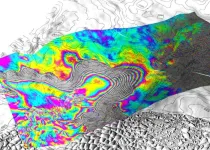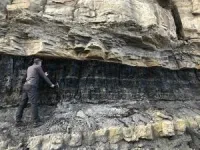(Press-News.org) Irvine, Calif., May 20, 2024 — A team of glaciologists led by researchers at the University of California, Irvine used high-resolution satellite radar data to find evidence of the intrusion of warm, high-pressure seawater many kilometers beneath the grounded ice of West Antarctica’s Thwaites Glacier.
In a study published today in Proceedings of the National Academy of Sciences, the UC Irvine-led team said that widespread contact between ocean water and the glacier – a process that is replicated throughout Antarctica and in Greenland – causes “vigorous melting” and may require a reassessment of global sea level rise projections.
The glaciologists relied on data gathered from March to June of 2023 by Finland’s ICEYE commercial satellite mission. The ICEYE satellites form a “constellation” in polar orbit around the planet, using InSAR – interferometer synthetic aperture radar – to persistently monitor changes on the Earth’s surface. Many passes by a spacecraft over a small, defined area render smooth data results. In the case of this study, it showed the rise, fall and bending of Thwaites Glacier.
“These ICEYE data provided a long-time series of daily observations closely conforming to tidal cycles,” said lead author Eric Rignot, UC Irvine professor of Earth system science. “In the past, we had some sporadically available data, and with just those few observations it was hard to figure out what was happening. When we have a continuous time series and compare that with the tidal cycle, we see the seawater coming in at high tide and receding and sometimes going farther up underneath the glacier and getting trapped. Thanks to ICEYE, we’re beginning to witness this tidal dynamic for the first time.”
ICEYE Director of Analytics Michael Wollersheim, co-author, said, “Until now, some of the most dynamic processes in nature have been impossible to observe with sufficient detail or frequency to allow us to understand and model them. Observing these processes from space and using radar satellite images, which provide centimeter-level precision InSAR measurements at daily frequency, marks a significant leap forward.”
Rignot said the project helped him and his colleagues develop a better understanding of the behavior of seawater on undersides of Thwaites Glacier. He said that seawater coming in at the base of the ice sheet, combined with freshwater generated by geothermal flux and friction, builds up and “has to flow somewhere.” Water is distributed through natural conduits or collects in cavities, creating enough pressure to elevate the ice sheet.
“There are places where the water is almost at the pressure of the overlying ice, so just a little more pressure is needed to push up the ice,” Rignot said. “The water is then squeezed enough to jack up a column of more than half a mile of ice.”
And it’s not just any seawater. For decades, Rignot and his colleagues have been gathering evidence of the impact of climate change on ocean currents, which push warmer seawater to the shores of Antarctica and other polar ice regions. Circumpolar deep water is salty and has a lower freezing point. While freshwater freezes at zero degrees Celsius, saltwater freezes at minus two degrees, and that small difference is enough to contribute to the “vigorous melting” of basal ice as found in the study.
Co-author Christine Dow, professor in the Faculty of Environment at the University of Waterloo in Ontario, Canada, said, “Thwaites is the most unstable place in the Antarctic and contains the equivalent of 60 centimeters of sea level rise. The worry is that we are underestimating the speed that the glacier is changing, which would be devastating for coastal communities around the world.”
Rignot said that he hopes and expects the results of this project to spur further research on the conditions beneath Antarctic glaciers, exhibitions involving autonomous robots and more satellite observations.
“There is a lot of enthusiasm from the scientific community to go to these remote, polar regions to gather data and build our understanding of what’s happening, but the funding is lagging,” he said. “We operate at the same budget in 2024 in real dollars that we were in the 1990s. We need to grow the community of glaciologists and physical oceanographers to address these observation issues sooner rather than later, but right now we’re still climbing Mount Everest in tennis shoes.”
In the near term, Rignot, who is also a senior project scientist at NASA’s Jet Propulsion Laboratory, said this study will provide a lasting benefit to the ice sheet modeling community.
“If we put this type of ocean-ice interaction into ice sheet models, I expect we will be able to do a much better job of reproducing what has happened in the past quarter century, which will lead to a higher level of confidence in our projections,” he said. “If we could add this process we outlined in the paper, which is not included in most current models, the model reconstructions should match observations much better. It would be a big win if we could achieve that.”
Dow added, “At the moment we don’t have enough information to say one way or the other how much time there is before the oceanwater intrusion is irreversible. By improving the models and focusing our research on these critical glaciers, we will try to get these numbers at least pinned down for decades versus centuries. This work will help people adapt to changing ocean levels, along with focusing on reducing carbon emissions to prevent the worst-case scenario.”
Rignot, Dow and Wollershiem were joined in this project by Enrico Ciraci, UC Irvine assistant specialist in Earth system science and NASA postdoctoral fellow; Bernd Scheuchl, UC Irvine researcher in Earth system science; and ICEYE’s Valentyn Tolpekin. ICEYE is headquartered in Finland and operates from five international locations, including the United States. The research received financial support from NASA and the National Science Foundation.
About the University of California, Irvine: Founded in 1965, UCI is a member of the prestigious Association of American Universities and is ranked among the nation’s top 10 public universities by U.S. News & World Report. The campus has produced five Nobel laureates and is known for its academic achievement, premier research, innovation and anteater mascot. Led by Chancellor Howard Gillman, UCI has more than 36,000 students and offers 224 degree programs. It’s located in one of the world’s safest and most economically vibrant communities and is Orange County’s second-largest employer, contributing $7 billion annually to the local economy and $8 billion statewide. For more on UCI, visit www.uci.edu.
Media access: Radio programs/stations may, for a fee, use an on-campus ISDN line to interview UCI faculty and experts, subject to availability and university approval. For more UCI news, visit news.uci.edu. Additional resources for journalists may be found at https://news.uci.edu/media-resources/.
END
UC Irvine-led team uncovers ‘vigorous melting’ at Antarctica’s Thwaites Glacier
Satellite radar data show kilometer-scale seawater intrusion, causing ice to rise and fall
2024-05-20
ELSE PRESS RELEASES FROM THIS DATE:
Warm seawater speeding up melting of ‘Doomsday Glacier,’ scientists warn
2024-05-20
EMBARGOED UNTIL 15:00 EDT MONDAY, MAY 20, 2024
For the first time, there is visible evidence showing that warm seawater is pumping underneath Antarctica’s Thwaites Glacier—ominously nicknamed the Doomsday Glacier.
An international team of scientists—including a researcher from the University of Waterloo—observed it using satellite imagery and warns that it could accelerate catastrophic sea level rise in 10 to 20 years.
The intrusion of seawater causes the ice to continuously lift off the land and settle back down again. Ice melts intensely when it first touches seawater, ...
Can coal mines be tapped for rare earth elements?
2024-05-20
Deposits of designated critical minerals needed to transition the world’s energy systems away from fossil fuels may, ironically enough, be co-located with coal deposits that have been mined to produce the fossil fuel most implicated in climate change.
Now, research led by the University of Utah has documented elevated concentrations of a key subset of critical minerals, known as rare earth elements, or REEs, in active mines rimming the Uinta coal belt of Colorado and Utah.
These findings open the possibility that these mines could see a secondary resource stream in the form of metals used in renewable energy and numerous other high-tech ...
Electric school buses may yield significant health and climate benefits, cost savings
2024-05-20
EMBARGOED FOR RELEASE: MONDAY, MAY 20, 2024, 3:00 PM ET
Key points:
Replacing an average diesel school bus from 2017 with an electric one may result in $84,200 in health and climate benefits—including fewer greenhouse gas emissions and reduced rates of mortality and childhood asthma—per individual bus.
Those benefits may increase to $247,600 per individual electric school bus replacing a diesel bus from 2005 or earlier in a large metropolitan area.
While the benefits of replacing diesel vehicles with electric ones are well known, this is the first study to specifically quantify the health and climate benefits of replacing diesel school buses with electric ...
Aston University experts team up with medical products company to help make endoscopes cleaner and safer
2024-05-20
Endoscopes are instruments that are used to look inside the body
Even with new developments cleaning them sufficiently has been a challenge
The University has entered a knowledge transfer partnership (KTP) with PFE Medical to improve the process by removing bacterial biofilm inside them.
Aston University experts are teaming up with a medical products company to improve the cleaning of endoscopes.
Endoscopes are long, thin instruments with a light and camera at one end that are used to look inside the body.
Cleaning them sufficiently has been a challenge and even with new developments they can ...
New method to reveal what drives brain diseases
2024-05-20
LA JOLLA, CA — The brain is often referred to as a “black box”—one that’s difficult to peer inside and determine what’s happening at any given moment. This is part of the reason why it’s difficult to understand the complex interplay of molecules, cells and genes that underly neurological disorders. But a new CRISPR screen method developed at Scripps Research has the potential to uncover new therapeutic targets and treatments for these conditions.
The method, outlined in a study published in Cell on May 20, 2024, provides a way to rapidly examine the brain cell types ...
AI chips could get a sense of time
2024-05-20
Image
Artificial neural networks may soon be able to process time-dependent information, such as audio and video data, more efficiently. The first memristor with a 'relaxation time' that can be tuned is reported today in Nature Electronics, in a study led by the University of Michigan.
Memristors, electrical components that store information in their electrical resistance, could reduce AI's energy needs by about a factor of 90 compared to today's graphical processing units. Already, AI is projected to account for about half a percent of the world's total electricity ...
PARC model of care associated with fewer deaths among veterans post-ICU
2024-05-20
EMBARGOED UNTIL: 10:15 a.m. PT, Monday, May 20, 2024
PARC MODEL OF CARE ASSOCIATED WITH FEWER DEATHS AMONG VETERANS POST-ICU
Session: B18 – Bridging Gaps to Improve Long-Term Outcomes
The Post-Acute Recovery Center: A Telehealth Care Model to Improve Patient-Centered Outcomes for High-Risk Survivors of Critical Illness
Date and Time: Monday, May 20, 2024, 10:15 a.m. PT
Location: San Diego Convention Center, Room 32A-B (Upper Level)
ATS 2024, San Diego – Research presented at the ATS 2024 International Conference demonstrates that veterans who received ...
Department of Energy announces $6 million for isotope R&D
2024-05-20
WASHINGTON, D.C. - Today, the U.S. Department of Energy (DOE) announced $6 million in funding for 12 awards across eight efforts to advance research in isotope enrichment, targetry, and separations. This funding is part of a key federal program that produces critical isotopes otherwise unavailable or in short supply in the U.S.
Isotopes, or variations of the same elements that have the same number of protons but different numbers of neutrons, have unique properties that make them powerful in medical diagnostic and treatment applications. They are also essential for applications in quantum information science, nuclear power, national security, and more.
“These ...
World leaders still need to wake up to AI risks, say leading experts ahead of AI Safety Summit
2024-05-20
UNDER EMBARGO UNTIL 19:00 BST / 14:00 ET MONDAY 20 MAY 2024.
World leaders still need to wake up to AI risks, say leading experts ahead of AI Safety Summit
More information, including a copy of the paper, can be found online at the Science press package at https://www.eurekalert.org/press/scipak/, or can be requested from scipak@aaas.org
Leading AI scientists are calling for stronger action on AI risks from world leaders, warning that progress has been insufficient since the first AI Safety Summit in Bletchley Park six months ago.
Then, the world’s leaders pledged to govern AI responsibly. However, as the second AI Safety Summit in Seoul ...
*FREE* Managing extreme AI risks amidst rapid technological development
2024-05-20
Although researchers have warned of the extreme risks posed by rapidly developing artificial intelligence (AI) technologies, there is a lack of consensus about how to manage them. In a Policy Forum, Yoshua Bengio and colleagues examine the risks of advancing AI technologies – from the social and economic impacts, malicious uses, and the possible loss of human control over autonomous AI systems – and recommend directions for proactive and adaptive governance to mitigate them. They call on major technology companies and public funders to invest more – at least one-third of their budgets – into assessing and ...
LAST 30 PRESS RELEASES:
The (metabolic) cost of life
CFRI special issue call for papers: New Frontiers in Sustainable Finance
HKU Engineering scholar demonstrates the smallest all-printed infrared photodetectors to date
Precision empowerment for brain "eavesdropping": CAS team develops triple-electrode integrated functional electrode for simultaneous monitoring of neural signals and chemical transmitters during sleep
Single-capillary endothelial dysfunction resolved by optoacoustic mesoscopy
HKU three research projects named among ‘Top 10 Innovation & Technology News in Hong Kong 2025’ showcasing excellence in research and technology transfer
NLRSeek: A reannotation-based pipeline for mining missing NLR genes in sequenced genomes
A strand and whole genome duplication–aware collinear gene identification tool
Light storage in light cages: A revolutionary approach to on-chip quantum memories
Point spread function decoupling in computational fluorescence microscopy
BacPhase: Long-insert paired-end sequencing for bin marker construction and genome phasing
GmWOX1 regulates the mediolateral polarity of compound leaves in soybean
ChargeFabrica: An open-source simulation tool that aims to accelerate search for high performance perovskite solar cells
High levels of ADAR overexpression induce abundant and stochastic off-target RNA editing in rice protoplasts
On-demand upgraded recycling of polyethylene and construction of sustainable multifunctional materials based on the "LEGO" strategy
New "Stomata in-sight" system allows scientists to watch plants breathe in real-time
Anorexia nervosa may result in long-term skeletal muscle impairment
Narrative-based performance reviews deemed fairest by employees
New insights reveal how advanced oxidation can tackle emerging water pollutants
New review shows how biomass can deliver low-carbon gaseous fuels at scale
Climate change is quietly rewriting the world’s nitrogen cycle, with high stakes for food and the environment
Study finds SGLT-2 inhibitors linked to lower risk of diabetic foot nerve damage
Microbes may hold the key to brain evolution
Study examines how the last two respiratory pandemics rapidly spread through cities
Gender stereotypes reflect the division of labor between women and men across nations
Orthopedics can play critical role in identifying intimate partner violence
Worms as particle sweepers
Second spider-parasitic mite described in Brazil
January 2026 issues of APA journals feature new research on autism, pediatric anxiety, psychedelic therapy, suicide prevention and more
Private equity acquired more than 500 autism centers over the past decade, new study shows
[Press-News.org] UC Irvine-led team uncovers ‘vigorous melting’ at Antarctica’s Thwaites GlacierSatellite radar data show kilometer-scale seawater intrusion, causing ice to rise and fall





